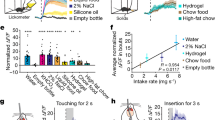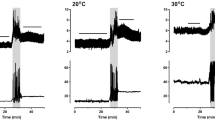Summary
-
1.
Food stimuli have been shown previously to elicit inAplysia an arousal state characterized by an increased tendency to bite and an increased strength of bitting. These overt behavioral changes have also been correlated with an increase in heart rate.
-
2.
In the present study, we show that systemic blood pressure increases two-fold during food arousal. Blood flow through the artery that supplies the head is also increased about two-fold. Pressure and flow both increase within 1–2 min of food presentation, and both decay back to their baseline values within about five minutes after removal of the food stimulus.
-
3.
Unlike the increase in heart rate during food arousal, the increases in blood pressure and blood flow are independent of the degree of satiation of the animal.
-
4.
The increase in blood pressure during food arousal is neurally mediated.
-
5.
During rhythmic biting, the vascular resistance of the abdominal and anterior aortae vary in an alternating pattern that is phase-locked to the biting cycle. This pattern of resistance changes is such that blood flow to digestive organs is maximal during the retraction phase of biting, whereas flow to the head is maximal during the protraction phase.
-
6.
The increase in resistance of the abdominal aorta during protraction is mediated by neuronal input to vasoconstrictor muscle.
-
7.
Strongly reducing blood flow to the head for even a few minutes significantly impairs the efficiency of biting movements.
Similar content being viewed by others
References
Advokat C (1980) Modulation of defensive reflexes inAplysia californica by appetitive stimulation. Behav Neural Biol 28:253–265
Bloom SR, Edwards AV, Hardy RN, Malinowska K, Silver M (1975) Cardiovascular and endocrine responses to feeding in the young calf. J Physiol 253:135–155
Dieringer N, Koester J, Weiss KR (1978) Adaptive changes in heart rate ofAplysia californica. J Comp Physiol 123:11–21
Folkow B, Gaskell P, Waaler BA (1970) Blood flow through hind limb muscle during heavy rhythmic exercise. Acta Physiol Scand 80:61–72
Gardiner RM (1980) The effect of feeding on cerebral blood flow and oxygen consumption in the new-born calf. J Physiol 301:429–438
Greenberg MJ, Price DA (1979) FMRF amide, a cardio-excitatory neuropeptide of molluscs: an agent in search of a mission. Am Zool 19:163–174
Hill RH, Yantorno RE (1979) Inotropism and contracture of Aplysiid ventricles as related to the action of neurohumors on resting and action potentials of molluscan hearts. Am Zool 19:145–162
Kandel ER (1979) Behavioral Biology ofAplysia. Freeman, San Francisco, p 78
Koch UT, Koester J, Weiss ER (1980) Neural control of cardiovascular responses during food arousal inAplysia. Soc Neurosci Abstr 6:461
Liebeswar G, Goldman JE, Koester J, Mayeri E (1975) Neural control of circulation inAplysia. J Neurophysiol 38:767–779
Mayeri E, Koester J, Kupfermann I, Liebeswar G, Kandel ER (1974) Neural control of circulation inAplysia. I. Motorneurons. J Neurophysiol 37:458–475
Sawada M, McAdoo DJ, Blankenship JE, Price CH (1981) Modulation of arterial muscle contraction inAplysia by glycine and neuron R14. Brain Res 207:486–490
Smith OA, Astley CA, Hohimer AR, Stephenson RB (1980) Behavioral and cerebral control of cardiovascular function. In: Hughes MJ, Barnes CD (eds) Neural control of circulation. Academic Press, New York, pp 1–21
Straub W (1904) Fortgesetzte Studien am Aplysien-Herzen (Dynamik, Kreislauf und dessen Innervation) nebst Bemerkungen zur vergleichenden Muskelphysiologie. Arch Ges Physiol 103:429–449
Weiss KR, Koch UT, Koester J, Mandelbaum DE, Kupfermann I (1981) Neural and molecular mechanisms of food-induced arousal inAplysia californica. In: Salanki J (ed) Adv Physiol Sci, vol 23, Neurobiology of invertebrates, pp 305–344
Author information
Authors and Affiliations
Rights and permissions
About this article
Cite this article
Koch, U.T., Koester, J. Time sharing of heart power: Cardiovascular adaptations to food-arousal inAplysia . J Comp Physiol B 149, 31–42 (1982). https://doi.org/10.1007/BF00735712
Accepted:
Issue Date:
DOI: https://doi.org/10.1007/BF00735712




